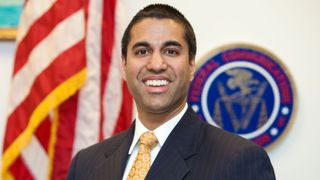Pai Proposes Dual-Use 5.9 GHz Band

FCC chair Ajit Pai has come to a decision on the 5.9 GHz band, the one currently reserved for vehicle-to-vehicle (V2V) communications: He is proposing to make the lower 45 MHz of the available for unlicensed use, including WiFi, while reserving the upper 30 MHz for the new Cellular Vehicle to Everything (C-V2X) approach to intelligent vehicle communications.
Of the 30 MHz for V2V, 20 MHz would definitely go to that new tech, but Pai is proposing seeking comment on whether to give the other 10 to C-V2X or the current DSRC technology, which appears to have been bypassed by the newer, cellular-based tech.
The chairman said it was past time to turn the page from a failed strategy and "score a major victory" for both V2V and unlicensed use.
Related: Pai Signals New Proceeding on 5.9 GHz
"The improvements in transportation technology that we’ve enabled demonstrate that many of the features originally envisioned for DSRC are being provided today by other means," the chairman said.
Pai announced the move Wednesday, pointing out it was a departure from the FCC's initial idea to allow sharing of DSRC with unlicensed use. "Preliminary testing of a sharing regime showed some promise," he said, but added that "further testing would be needed to carry out a complex sharing regime, and more testing would mean this valuable spectrum would likely lie fallow for several years...So moving forward, let’s resist the notion that we have to choose between automotive safety and WiFi. My proposal would do far more for both automotive safety and WiFi than the status quo."
Pai has scheduled a vote vote on the item at the Dec. 12 meeting.
Broadcasting & Cable Newsletter
The smarter way to stay on top of broadcasting and cable industry. Sign up below
Cable operators have been pushing the FCC to free up that spectrum for WiFi hot spots, which is still their principal mobile broadband play.
NCTA-The Internet & Television Association has been advising the FCC to stick to its planned route and free up some Vehicle-to-Vehicle (V2) spectrum for WiFi rather than detour at the behest of intelligent transportation system commenters who want to take it down the road of "a failed technology-specific approach to spectrum policy."
Pai has combined the roads into what he sees as the best route to innovation in both spheres.
Contributing editor John Eggerton has been an editor and/or writer on media regulation, legislation and policy for over four decades, including covering the FCC, FTC, Congress, the major media trade associations, and the federal courts. In addition to Multichannel News and Broadcasting + Cable, his work has appeared in Radio World, TV Technology, TV Fax, This Week in Consumer Electronics, Variety and the Encyclopedia Britannica.

